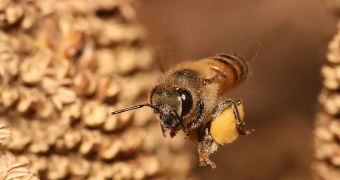A recent survey of eleven species of wild bees has revealed that the insects were carrying a number of the viruses that are currently threatening to collapse domesticated honeybee populations. Experts say that the contamination most likely occurred via flower pollen.
The research was conducted in the United States, on wild bee species that play a critical role as pollinators in their natural habitat. It would appear that all the creatures shared common grounds with honeybees that were diseased.
According to researchers, virtually none of the wild pollinators was ever recorded as carrying any of the viruses infecting honeybees, which means that the contamination occurred either directly or through a single intermediary.
The natural culprits that come to mind are the flowers, which are pollinated by both honeybees and wild bees. The former may easily contaminate their “landing sites” with viruses, which are then picked up by the wild species that are also passing through.
A major implication of the study is that the number of diseases that can be swapped from domesticated to wild bee species has just increased, says expert Diana Cox-Foster.
The expert, who is based at the Pennsylvania State University (Penn State) in University Park, published the results of her team's study in the December 22 online issue of the peer-reviewed journal PLoS ONE, which is edited by the Public Library of Science.
Up until now, experts still believed that honeybee viruses will remain in these populations, and not spread any further. The new conclusions cancel those hopes. “Movement of any managed pollinator may introduce viruses,” the team leader says.
But there were also unexpected twists in the research, such as for example the discovery of the deformed-wing virus and sacbrood virus in pollen carried by foraging bees that were not infected.
According to University of California in San Francisco (UCSF) expert Michelle Flenniken, who was not a part of the new work, that is highly uncommon, and may hint at the existence of some defense mechanisms in particular wild bee species.
Over the past couple years, a mysterious plague called simply colony collapse disorder (CCD) has been wiping out hives across the world, by attacking worker bees. Many colonies have already been lost.
The situation is most dire in the United Kingdom, where an extremely large proportion of bee populations have either died, or are heavily affected by the ensemble of viruses and environmental factors underlying CCD, Wired reports.

 14 DAY TRIAL //
14 DAY TRIAL //